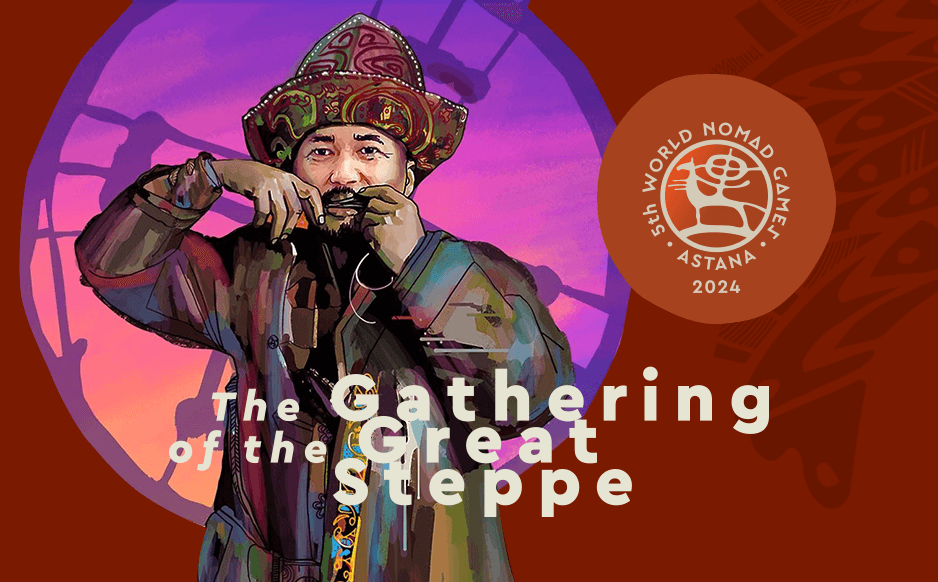Alysh
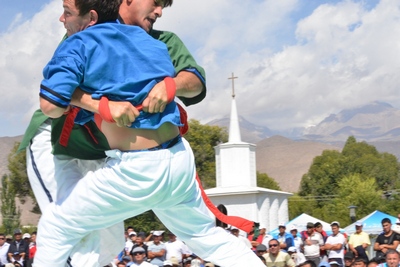 The history of belt wrestling “Alysh” is rooted in the distant past. This kind of fighting is one of the ancient sport games of the Kyrgyz people. It is the oldest form of martial arts where two wrestlers fight wearing clothes and belts.
The history of belt wrestling “Alysh” is rooted in the distant past. This kind of fighting is one of the ancient sport games of the Kyrgyz people. It is the oldest form of martial arts where two wrestlers fight wearing clothes and belts.
There is historical evidence of the 6,000-year long existence of belt wrestling, confirmed by ancient artifacts. The most significant artifact is a bronze statuette of two wrestlers found in Baghdad. There are also notes about belt wrestling in the literature of more than 70 countries in Europe and Asia. But, perhaps, for the first time it was described in a masterpiece of Kyrgyz folklore, the “Manas” epic, where historical figures Koshoy and Zholoy are wrestling by the rules of Alysh. This information has very high historical value, and it prooves that Alysh has existed as long as the Kyrgyz people have existed. At his own times, Abu Ali Ibn Sina scientificly proved the great value of exercise in medicine. He also gave references to belt wrestling. He described how two men try to topple each other by holding and pulling each others belts. Today, belt wrestling continues to grow in popularity not only in Central Asia, but also in other countries over the world. Due to this, the idea of founding the International Federation on the lands of Ala-Too was created.
Salbuurun
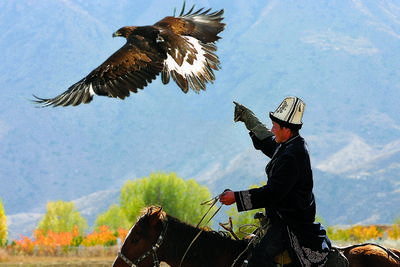 Kyrgyz people had a tradition of long group hunting, which is called salbuurun. There is saying in the folklore of Kyrgyz people: “alty ay, jeti ay jogolup, salbuurun ketip kalbasyn”, which means “wish he will not go far hunting and disappear for 6-7 months”. Hunters gathered together and went to hunt in the mountains for several days. They took the best horses, golden eagles and hunting dogs, along with bows and arrows. Food was gathered on the way. During such trips the best hunters, horses, eagles and dogs were discovered. It was a kind of selection. There is an assumption that Kyrgyzs’ favorite game “Kok-boru” takes its origins from Salbuurun. Often hunters managed to hunt down wolves with the help of taigans, special hunting dogs of the Kyrgyz. While returning home, the most nimble horseman would put the body of a wolf across the saddle and would try to gallop far ahead. The others in turn tried to catch up with him and take away the wolf. Thus, playing catch-up games, the most agile rider would return to the home village and throw the wolf’s carcass near the elder’s yurt. Salbuurun was also a test of courage and agility of horsemen. In some regions of Kyrgyzstan, a real Jigit is one who uses not gunpowder and iron, but a bow, a dog and a golden eagle to hunt gamebirds and protect sheep from predators. It is clear that not only the hunter proves his courage, but also his loyal friend – taigan, or hunting dogs.
Kyrgyz people had a tradition of long group hunting, which is called salbuurun. There is saying in the folklore of Kyrgyz people: “alty ay, jeti ay jogolup, salbuurun ketip kalbasyn”, which means “wish he will not go far hunting and disappear for 6-7 months”. Hunters gathered together and went to hunt in the mountains for several days. They took the best horses, golden eagles and hunting dogs, along with bows and arrows. Food was gathered on the way. During such trips the best hunters, horses, eagles and dogs were discovered. It was a kind of selection. There is an assumption that Kyrgyzs’ favorite game “Kok-boru” takes its origins from Salbuurun. Often hunters managed to hunt down wolves with the help of taigans, special hunting dogs of the Kyrgyz. While returning home, the most nimble horseman would put the body of a wolf across the saddle and would try to gallop far ahead. The others in turn tried to catch up with him and take away the wolf. Thus, playing catch-up games, the most agile rider would return to the home village and throw the wolf’s carcass near the elder’s yurt. Salbuurun was also a test of courage and agility of horsemen. In some regions of Kyrgyzstan, a real Jigit is one who uses not gunpowder and iron, but a bow, a dog and a golden eagle to hunt gamebirds and protect sheep from predators. It is clear that not only the hunter proves his courage, but also his loyal friend – taigan, or hunting dogs.
Ordo
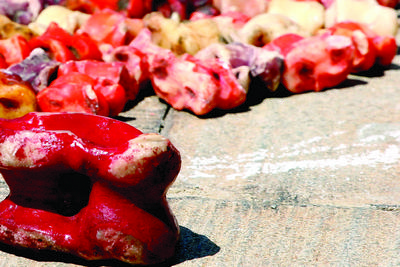 Ordo is one of the most popular games in Kyrgyzstan, and has come from ancient times. The word “Ordo” means “Khan’s headquarters, the Khan’s palace”. The game represents the battle for capturing the Khan’s headquarters. Ordo is a kind of military map with which soldiers were taught how and in what way you can defeat the enemy. A drawn circle on the ground marks the territory of the enemy. Rivals would develop a battle plan. Knocking down Khan meant the overthrow of the throne of the governor. The core of the game is also based on the ability to conduct correct internal policies while being inside the circle, which means being in power. It is no coincidence that in “Manas”, the warriors play ordo before the Great March to Beijing. They seem to be carrying out the general rehearsal for the upcoming great battle.
Ordo is one of the most popular games in Kyrgyzstan, and has come from ancient times. The word “Ordo” means “Khan’s headquarters, the Khan’s palace”. The game represents the battle for capturing the Khan’s headquarters. Ordo is a kind of military map with which soldiers were taught how and in what way you can defeat the enemy. A drawn circle on the ground marks the territory of the enemy. Rivals would develop a battle plan. Knocking down Khan meant the overthrow of the throne of the governor. The core of the game is also based on the ability to conduct correct internal policies while being inside the circle, which means being in power. It is no coincidence that in “Manas”, the warriors play ordo before the Great March to Beijing. They seem to be carrying out the general rehearsal for the upcoming great battle.
Er enish
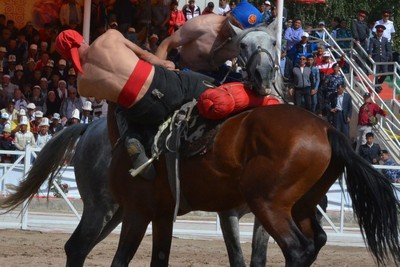 Er enish is a traditional wrestling of horsemen. The rules and accessories of this sport suggest that it was derived for military needs and purposes. Rules permit dangerous actions performed without any insurance. They can be regarded as cruel methods of melee combat to take down the enemy, for example grabbing ribs and muscles of the hands, or turning out the joints. Both the rider’s and the horse’s strength and abilities have equal significance in this game. Horses for er enish should be heavy, strong, stable, maneuverable, quiet and obedient.
Er enish is a traditional wrestling of horsemen. The rules and accessories of this sport suggest that it was derived for military needs and purposes. Rules permit dangerous actions performed without any insurance. They can be regarded as cruel methods of melee combat to take down the enemy, for example grabbing ribs and muscles of the hands, or turning out the joints. Both the rider’s and the horse’s strength and abilities have equal significance in this game. Horses for er enish should be heavy, strong, stable, maneuverable, quiet and obedient.
At Chabysh
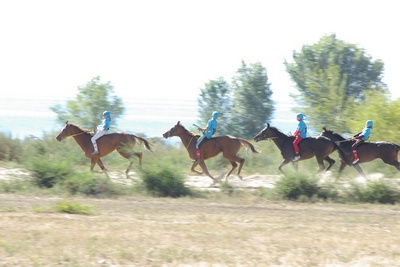 It is impossible to imagine life of Kyrgyz without horses. Kyrgyz men believed that horses and he are one. Kyrgyz people “are born and die” on a horse. There are lots of sayings and legends associated with the horse. “Manas” describes how Manas mourned the death of his inseparable and wise horse Ak-Kula during the Battle for Beijing. To find a suitable horse was very important for the Kyrgyz people. Special experts called “Synchy” would accurately determine a real racer by taking into consideration the weight of horse, muscles, blood vessels, breathing, gait and other factors. Both everyday life and entertainment of the Kyrgyz were associated with horses, among which we would like to mention horse racing. At Chabysh (horse racing) is very entertaining, but also it has high social and political significance. Race would serve as way to solve many problems between tribes. Race conducted mainly during the festive holidays. “Kokotay’s funeral” from the “Manas” epic is the clearest example. It thouroughly describes the importance of entertainment and horse racing. All horse breeds and ages could be involved in horse races. Each sayapker (horse trainer) had its very own unique ways of training the horse to obtain the highest level of performance.
It is impossible to imagine life of Kyrgyz without horses. Kyrgyz men believed that horses and he are one. Kyrgyz people “are born and die” on a horse. There are lots of sayings and legends associated with the horse. “Manas” describes how Manas mourned the death of his inseparable and wise horse Ak-Kula during the Battle for Beijing. To find a suitable horse was very important for the Kyrgyz people. Special experts called “Synchy” would accurately determine a real racer by taking into consideration the weight of horse, muscles, blood vessels, breathing, gait and other factors. Both everyday life and entertainment of the Kyrgyz were associated with horses, among which we would like to mention horse racing. At Chabysh (horse racing) is very entertaining, but also it has high social and political significance. Race would serve as way to solve many problems between tribes. Race conducted mainly during the festive holidays. “Kokotay’s funeral” from the “Manas” epic is the clearest example. It thouroughly describes the importance of entertainment and horse racing. All horse breeds and ages could be involved in horse races. Each sayapker (horse trainer) had its very own unique ways of training the horse to obtain the highest level of performance.
Toguz Korgool
 Toguz korgool belongs to the family of mancala games. The word Mancala is derived from the word for “move, movement”. Different types of mankala are very popular all over the world. There are about 400 types of this game. It is most popular in Africa, where more than 90 varieties exist. Each of them has its own differences and characteristics of each individual nation. The importance and role of mancala games in Asia and Africa are appropriate for comparison with the value and role of the game of chess in the West. Though mankala games are spread across a wide area – Africa, the Caribbean, South America and Europe - there is one common thing, which is acquisition of stones. In the Kyrgyz version of this game – toguz (nine) korgool, the goal of each player is also the acquisition of the largest possible number of korgool (stones). Stones similar in size and structure were used in the game. Why nine? Because nine is a sacred number of nomadic Turkic peoples, including Kyrgyz people. Toguz korgool known in Kazakhstan as “togyz kumalak” and in Turkey “dokuz kumalak”. Rules of the above games are identical, and they are only known by different names. The meaning of game implies the development of military strategic thinking of nations during peacetime. The main purpose of game is conquering the troops, wealth and estates of the enemy. At the same time, each korgool symbolizes a warrior. Another difference of toguz korgool from other mankala games is that according to the rules of the game, one of the retrieved stones is required to be left in the same hole. This is a kind of reflection of the father’s tradition of conservation focus in the social life of the nomadic Turkic people.
Toguz korgool belongs to the family of mancala games. The word Mancala is derived from the word for “move, movement”. Different types of mankala are very popular all over the world. There are about 400 types of this game. It is most popular in Africa, where more than 90 varieties exist. Each of them has its own differences and characteristics of each individual nation. The importance and role of mancala games in Asia and Africa are appropriate for comparison with the value and role of the game of chess in the West. Though mankala games are spread across a wide area – Africa, the Caribbean, South America and Europe - there is one common thing, which is acquisition of stones. In the Kyrgyz version of this game – toguz (nine) korgool, the goal of each player is also the acquisition of the largest possible number of korgool (stones). Stones similar in size and structure were used in the game. Why nine? Because nine is a sacred number of nomadic Turkic peoples, including Kyrgyz people. Toguz korgool known in Kazakhstan as “togyz kumalak” and in Turkey “dokuz kumalak”. Rules of the above games are identical, and they are only known by different names. The meaning of game implies the development of military strategic thinking of nations during peacetime. The main purpose of game is conquering the troops, wealth and estates of the enemy. At the same time, each korgool symbolizes a warrior. Another difference of toguz korgool from other mankala games is that according to the rules of the game, one of the retrieved stones is required to be left in the same hole. This is a kind of reflection of the father’s tradition of conservation focus in the social life of the nomadic Turkic people.
Kyrgyz Kurosh
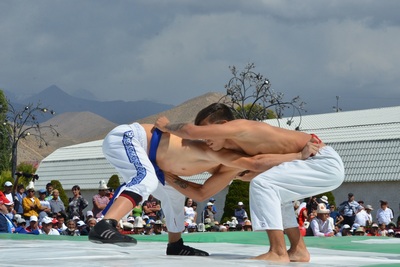 Besides legendary descriptions, there is also historical evidence of waist wrestling, which is one of the main types of traditional sport among nomads. A 10 cm long sculpture was found in Mesopotamia, which is from 2500 BC. The sculptures show two waist wrestlers with vases on their heads. In a well-known Chinese manuscript “Tan Shu” of the tenth century, Nooruz festivities are described in the Ferghana Valley, and competitions of waist wrestling are mentioned. A century later, Ali ibn Abu Sina mentions the importance of physical exercise by giving the example of waist wrestling. After time, Kurosh became an independent combat element which was taught to soldiers to prepare for war. Speaking of its applied value in the Middle Ages for the nomads, Hungarian sports historian Laszlo Kun said: “During waist wrestling competitions, warriors learn to pull a fleeing rider from his saddle with bare hands.” Kyrgyz people attached great importance to the fight. The Manas epic has an episode where Koshoy wrestles with Joloy (a Kalmak villain) for seven days. The description is bright and detailed, and inlcudes the prelude, course of the fight, victory, and even describes such specifics which are forgotten by modern Kyrgyz wrestling specialists.
Besides legendary descriptions, there is also historical evidence of waist wrestling, which is one of the main types of traditional sport among nomads. A 10 cm long sculpture was found in Mesopotamia, which is from 2500 BC. The sculptures show two waist wrestlers with vases on their heads. In a well-known Chinese manuscript “Tan Shu” of the tenth century, Nooruz festivities are described in the Ferghana Valley, and competitions of waist wrestling are mentioned. A century later, Ali ibn Abu Sina mentions the importance of physical exercise by giving the example of waist wrestling. After time, Kurosh became an independent combat element which was taught to soldiers to prepare for war. Speaking of its applied value in the Middle Ages for the nomads, Hungarian sports historian Laszlo Kun said: “During waist wrestling competitions, warriors learn to pull a fleeing rider from his saddle with bare hands.” Kyrgyz people attached great importance to the fight. The Manas epic has an episode where Koshoy wrestles with Joloy (a Kalmak villain) for seven days. The description is bright and detailed, and inlcudes the prelude, course of the fight, victory, and even describes such specifics which are forgotten by modern Kyrgyz wrestling specialists.
Kok-Boru
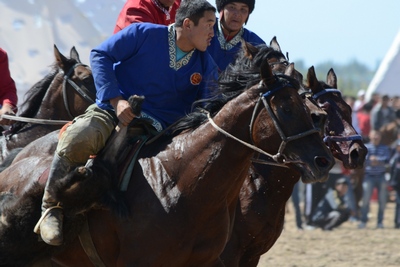 “Kok-boru” is translated as gray wolf. The origin of this game lies in the distant past. In a society of nomads, hunters would feed their family, while old people and women would take care of cattle. Wolves often attacked the cattle, bringing disaster. After returning from the hunt, angry horsemen would pursue wolves on their fast horses. When reaching the wolf pack, rider would pick up a running wolf from the ground, throw it to each other, and even playfully pull it away from each other. There is another interesting version. According to this version during the celebration of toy ( great holiday) a live wolf would be released in front of men and men would be challenged to take it to the elder’s yurt. Only the bravest of them would grab a wolf while riding a horse, hold it with legs and bring it to the destination. But it is not that easy. Other horsemen tried to take away the wolf. The one who was able to drop off a wolf to the elder’s yurt received a blessing and baige (prize). The main goal of the game is military training, and the indirect purpose is entertainment. Kok-boru is a test of both a rider’s and his horse’s courage. For example, horses that could not jump over a fallen rider or horse during the game were considered unfit for war, and thus rejected.
“Kok-boru” is translated as gray wolf. The origin of this game lies in the distant past. In a society of nomads, hunters would feed their family, while old people and women would take care of cattle. Wolves often attacked the cattle, bringing disaster. After returning from the hunt, angry horsemen would pursue wolves on their fast horses. When reaching the wolf pack, rider would pick up a running wolf from the ground, throw it to each other, and even playfully pull it away from each other. There is another interesting version. According to this version during the celebration of toy ( great holiday) a live wolf would be released in front of men and men would be challenged to take it to the elder’s yurt. Only the bravest of them would grab a wolf while riding a horse, hold it with legs and bring it to the destination. But it is not that easy. Other horsemen tried to take away the wolf. The one who was able to drop off a wolf to the elder’s yurt received a blessing and baige (prize). The main goal of the game is military training, and the indirect purpose is entertainment. Kok-boru is a test of both a rider’s and his horse’s courage. For example, horses that could not jump over a fallen rider or horse during the game were considered unfit for war, and thus rejected.

 Kyrgyz people had a tradition of long group hunting, which is called salbuurun. There is saying in the folklore of Kyrgyz people: “alty ay, jeti ay jogolup, salbuurun ketip kalbasyn”, which means “wish he will not go far hunting and disappear for 6-7 months”. Hunters gathered together and went to hunt in the mountains for several days. They took the best horses, golden eagles and hunting dogs, along with bows and arrows. Food was gathered on the way. During such trips the best hunters, horses, eagles and dogs were discovered. It was a kind of selection. There is an assumption that Kyrgyzs’ favorite game “Kok-boru” takes its origins from Salbuurun. Often hunters managed to hunt down wolves with the help of taigans, special hunting dogs of the Kyrgyz. While returning home, the most nimble horseman would put the body of a wolf across the saddle and would try to gallop far ahead. The others in turn tried to catch up with him and take away the wolf. Thus, playing catch-up games, the most agile rider would return to the home village and throw the wolf’s carcass near the elder’s yurt. Salbuurun was also a test of courage and agility of horsemen. In some regions of Kyrgyzstan, a real Jigit is one who uses not gunpowder and iron, but a bow, a dog and a golden eagle to hunt gamebirds and protect sheep from predators. It is clear that not only the hunter proves his courage, but also his loyal friend – taigan, or hunting dogs.
Kyrgyz people had a tradition of long group hunting, which is called salbuurun. There is saying in the folklore of Kyrgyz people: “alty ay, jeti ay jogolup, salbuurun ketip kalbasyn”, which means “wish he will not go far hunting and disappear for 6-7 months”. Hunters gathered together and went to hunt in the mountains for several days. They took the best horses, golden eagles and hunting dogs, along with bows and arrows. Food was gathered on the way. During such trips the best hunters, horses, eagles and dogs were discovered. It was a kind of selection. There is an assumption that Kyrgyzs’ favorite game “Kok-boru” takes its origins from Salbuurun. Often hunters managed to hunt down wolves with the help of taigans, special hunting dogs of the Kyrgyz. While returning home, the most nimble horseman would put the body of a wolf across the saddle and would try to gallop far ahead. The others in turn tried to catch up with him and take away the wolf. Thus, playing catch-up games, the most agile rider would return to the home village and throw the wolf’s carcass near the elder’s yurt. Salbuurun was also a test of courage and agility of horsemen. In some regions of Kyrgyzstan, a real Jigit is one who uses not gunpowder and iron, but a bow, a dog and a golden eagle to hunt gamebirds and protect sheep from predators. It is clear that not only the hunter proves his courage, but also his loyal friend – taigan, or hunting dogs. Ordo is one of the most popular games in Kyrgyzstan, and has come from ancient times. The word “Ordo” means “Khan’s headquarters, the Khan’s palace”. The game represents the battle for capturing the Khan’s headquarters. Ordo is a kind of military map with which soldiers were taught how and in what way you can defeat the enemy. A drawn circle on the ground marks the territory of the enemy. Rivals would develop a battle plan. Knocking down Khan meant the overthrow of the throne of the governor. The core of the game is also based on the ability to conduct correct internal policies while being inside the circle, which means being in power. It is no coincidence that in “Manas”, the warriors play ordo before the Great March to Beijing. They seem to be carrying out the general rehearsal for the upcoming great battle.
Ordo is one of the most popular games in Kyrgyzstan, and has come from ancient times. The word “Ordo” means “Khan’s headquarters, the Khan’s palace”. The game represents the battle for capturing the Khan’s headquarters. Ordo is a kind of military map with which soldiers were taught how and in what way you can defeat the enemy. A drawn circle on the ground marks the territory of the enemy. Rivals would develop a battle plan. Knocking down Khan meant the overthrow of the throne of the governor. The core of the game is also based on the ability to conduct correct internal policies while being inside the circle, which means being in power. It is no coincidence that in “Manas”, the warriors play ordo before the Great March to Beijing. They seem to be carrying out the general rehearsal for the upcoming great battle.








